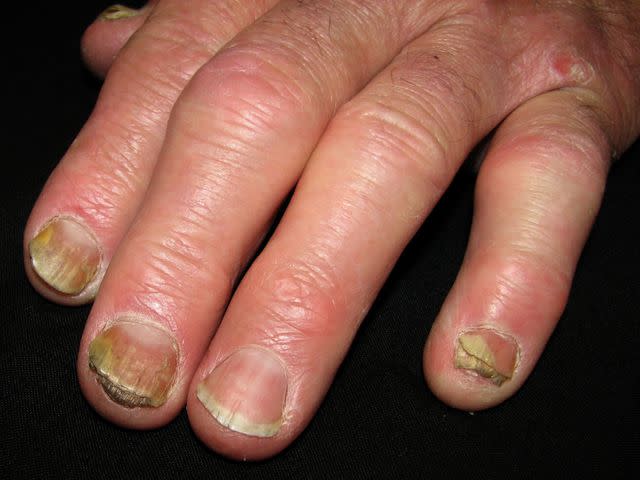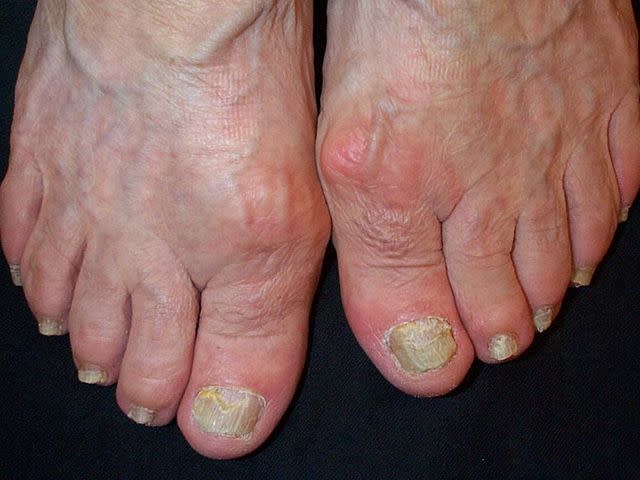How Does Psoriatic Arthritis Affect Your Nails?

Tatiana Foxy / Getty Images
Medically reviewed by David Ozeri, MD
If you live with psoriatic arthritis (PsA), chances are you’ve noticed changes to your fingernails and toenails. In addition to affecting your joints and skin, psoriatic arthritis can affect your nails, too. About 80% of people with PsA have nail symptoms, including nail pitting, crumbling, discoloration, thickening, and separation of the nail from the nail bed. These nail changes can not only be bothersome cosmetically but can also cause pain and discomfort that impact your overall quality of life.
Understanding nail-related symptoms of psoriatic arthritis can help you detect nail problems early and seek proper treatment to help improve the appearance and function of your nails.
What Is Psoriatic Arthritis?
Psoriatic arthritis (PsA) is a chronic autoimmune inflammatory condition that causes joint pain, swelling, and stiffness. It is closely associated with psoriasis, a skin disorder characterized by red, scaly patches on the skin. PsA often develops within 7 to 10 years after skin symptoms (psoriasis) first appear.
PsA commonly affects large joints, such as the shoulders and knees, but can also cause pain and stiffness in the back, pelvis, fingers, and toes. While PsA primarily affects the joints and skin, it can also affect other body parts, including the nails, eyes, and internal organs in some cases. Early diagnosis and treatment can help prevent long-term joint damage and improve the quality of life of people living with PsA.
Related: What Are The Symptoms of Psoriatic Arthritis?
Causes of PsA
With psoriatic arthritis, the immune system mistakenly attacks healthy tissues as a threat, leading to inflammation. Chronic inflammation can lead to symptoms such as pain, stiffness, and swelling that range from mild to severe.
The exact cause of psoriatic arthritis is not fully understood, but genetics and environmental triggers likely play a role in its development. Between 30-55% of people living with PsA have a family member with a history of the condition. While a genetic predisposition can increase the likelihood of developing PsA, other factors may also trigger its onset, such as:
Infection—especially infections involving hospitalization
Injury to the affected joint(s)
Physical stress such as heavy lifting and oxidative stress associated with smoking
Having obesity
Why Are Nails Involved in Psoriatic Arthritis?
Your fingernails and toenails are made from skin cells (keratin) and are considered extensions of the skin. Psoriasis causes skin cells to grow more rapidly than normal, leading to thick, scaly patches of skin. Because psoriatic arthritis often affects the skin, it can also affect the skin cells that make up your nails, leading to nail changes.
Fingernails are more commonly affected by PsA nail changes than toenails; experts believe this is because fingernails grow faster. For some people, nail symptoms develop before the onset of psoriatic arthritis, while others may experience nail changes later in the disease progression. People with psoriasis who develop nail changes are at an increased risk of psoriatic arthritis.
Related: 9 Things Your Nails Can Tell You About Your Health
What Do Psoriatic Arthritis Nails Look Like?
The type of nail changes involved in PsA depends on the part of the nail affected: the nail matrix, the nail bed, or both. The nail matrix is the tissue beneath the base of the nail responsible for nail growth, and the nail bed is the skin beneath the nail plate.

Dermnet NZ
Common nail changes associated with psoriatic arthritis include:
Pitting: Small pits, or dents, on the surface of the nails are common with PsA. The pits on the nail plate (the hard surface that protects the skin underneath) can be shallow or deep, and several can appear on the same nail.
Deformation: PsA can cause the nail plate to change in shape.
Onycholysis: When the nail plate lifts or detaches from the nail bed. This can create a space between the nail and the nail bed, and debris may collect in this area.
Thickening: The accumulation of dry, flaky material under the nail plate, causing the nails to thicken.
Beau’s lines: Horizontal ridges or grooves that form on the nail plate that may feel rough when touched.
Discoloration: The nails may appear discolored, with areas of yellow-brown or oil spots (salmon patches) on the nail plate.
Fungal infection (onychomycosis): Nails affected by PsA are more likely to develop secondary fungal infections.

Dermnet NZ
When to Contact a Healthcare Provider
If you have psoriasis or psoriatic arthritis, checking your fingernails and toenails for changes can help you detect nail psoriasis early. Talk to your healthcare if you notice:
Small dents in your nails
Discoloration on your nails (e.g., yellow, brown)
Thickened or crumbling nails
Flaky build-up or blood under your nails
Early detection and treatment can restore the health of your nails and prevent worsening symptoms, such as pain, discomfort, and infection.
Your healthcare provider may refer you to a rheumatologist (a doctor specializing in rheumatic conditions such as psoriatic arthritis) and/or a dermatologist (a doctor specializing in conditions affecting the skin, hair, and nails).
Treatment and Care
If your nails are affected by psoriatic arthritis, you may feel self-conscious about their appearance, or have pain that makes it difficult to carry out your daily tasks. Though nail psoriasis can be challenging to treat, a combination of self-care strategies and treatments from a healthcare provider can help control symptoms, improve nail health, and prevent future complications.
Self-Care
Practicing good nail hygiene and care is one of the best things you can do to help manage psoriatic nails. This includes:
Keep your nails clean and trimmed to help prevent buildup under the nails
Wear gloves when doing manual work, including dishes, yard work, and home repairs to prevent injury to the nails and skin, which can worsen symptoms
Moisturize your hands and heels with a thick cream or ointment to keep your skin well-hydrated
Avoid picking at or biting your cuticles and nails to prevent injury and worsening symptoms
Do not scrape or pick debris, dirt, or build-up from under your nails, which increases the risk of infection
Skip acrylic nails and opt for gentle nail buffing to smooth the nail surface and nail polish, which is safe to use
Treatment
Depending on the specific nail symptoms, your healthcare may prescribe medications to help manage symptoms and improve the appearance and health of your nails. This may include:
Topical medications: Topical treatments, such as corticosteroid creams or ointments, are applied directly to the nails to reduce symptoms.
Corticosteroid injections: Corticosteroid injections administered directly into the affected nails can help reduce inflammation and improve the appearance and function of nails.
Light therapy (phototherapy): This involves exposing the nails and skin to controlled ultraviolet (UV) light, which may help reduce inflammation and improve psoriatic nail symptoms.
Systemic (bodywide) medications: Oral or injectible medications may be prescribed to treat widespread psoriatic arthritis that affects the joints, nails, and skin. These can include disease-modifying antirheumatic drugs (DMARDs) or biologics, which help suppress the immune system and reduce inflammation.
A Quick Review
Psoriatic arthritis is a chronic inflammatory condition affecting the joints, skin, and nails. When your nails are affected, you may notice nail pitting (dents), discoloration, ridges, or separation of the nail from the nail bed. If you have psoriatic arthritis or psoriasis and notice changes to your nails, talk to a healthcare provider.
Early detection and treatment can help improve the appearance and function of your nails and prevent complications. Treatment options include topical medications, corticosteroid injections, phototherapy, systemic medications, and nail care practices. While living with psoriatic nails can be challenging, treatment can help reduce symptoms and improve your quality of life.
For more Health news, make sure to sign up for our newsletter!
Read the original article on Health.

